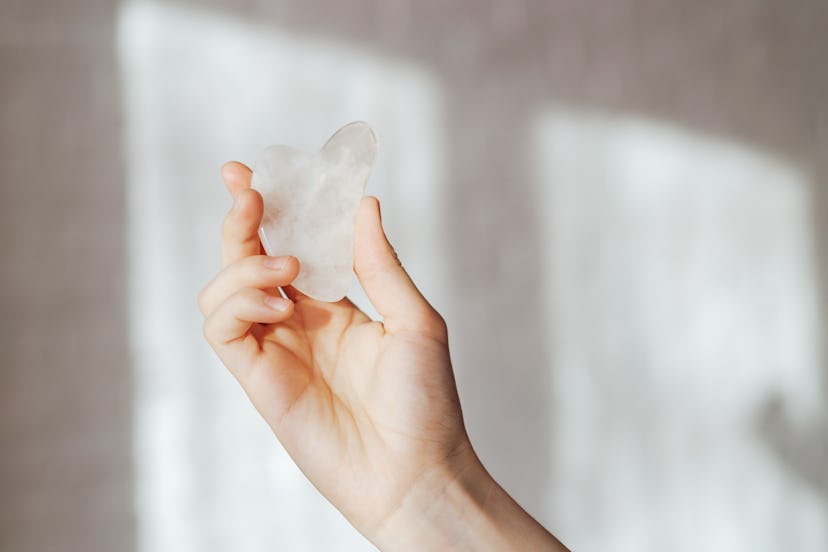Beauty Rituals
6 Asian Beauty Rituals That Soothe Your Skin, Scalp & Mind
Plus, the AAPI-owned brands to shop for each.

2023 concludes the dyanic, roaring Year of the Tiger and ushers in the Year of the Rabbit. In many Asian traditions and mythos, rabbits are gentle creatures that symbolize peace, longevity, and luck. The Rabbit embodies the softness of Yin, and contrasts against the intensity of the Tiger’s Yang. And now that it feels like the world is finally starting to settle into a sense of normalcy after the chaos of the last few years, this finally feels like a moment to actually slow down, take our time to catch our breath, and soften the way we treat ourselves. With the Lunar New Year approaching, there’s no better time to reflect and develop a new ritual or two. Need some inspiration? Ahead, find a list of beauty and wellness practices from Asia that you can easily incorporate into your own routine, plus the AAPI-owned brands to help you practice them.
Gua Sha
Gua sha traces its history back to China as far back as the Stone Age, and is rooted in the philosophy that wellness and beauty are one in the same — if you weren’t sleeping or eating well, or were carrying too much stress, your skin would be directly affected by that. The “gua” in gua sha means to “pull” or “scrape”, and the “sha'' means “petechiae” (referring to the brown-red spots that appear after a lot of gua sha). It’s practiced with a smooth, flat tool (it could be jade, quartz, or even stainless steel) and has become a popular way to de-puff and lift the skin — and many practitioners now use it to help with lymphatic drainage. Some of the best (and often overlooked!) benefits of gua sha can relieve chronic tension in the chest, jaw, or cheeks. But it’s ultimately just a type of massage that you can practice with yourself — a moment of quiet practice for you to reclaim time for yourself to care for your skin, body, and holistic well-being.
Champi (Hair Oiling)
Found in Indian Ayurvedic practice as far back as 600 BC, champi is the ritual of scalp oiling and massaging. Most often practiced before washing your hair or just going to sleep at night, regular champi regularly helps reduce scalp and hair dryness, improve the strength and shine of hair, and is even said to encourage hair growth due to increased blood circulation to the scalp. But beyond the physical benefits, it’s also a time for family members to come together, with female family members doing champi on each other and passing the time to talk about their day, tell stories, and bond.
Mugwort Baths
Mugwort baths have roots in East Asia and are still practiced there frequently. Considered an anti-inflammatory, warming herb, mugwort is often used in hot baths to soothe the skin and improve the body’s circulation (especially during winter). Because using mugwort in a hot bath can improve the body’s circulation, mugwort baths can also help alleviate menstrual discomfort. It can also help with muscle stiffness and soreness — not to mention the aromatherapy benefits after a long day.
Jamu
Jamu is an Indonesian health practice centered on healing the body with herbs. It draws on inspiration and knowledge from countries near it, like India, China, and various Arab countries. Usually often associated with health tonics, like turmeric and ginger drinks, Jamu-based skin care draws heavily on traditional Indonesian plants, spices, herbs, and roots to treat whatever skin issues you’re dealing with.
Double Cleansing
Double cleansing was first used in the 14th century by Japanese geishas and Korean gisaengs to break down the face makeup they wore when they were working and performing. Their makeup was so thick that their usual soap and elbow grease just wasn’t cutting it, so they learned to slather their faces with oil and massage the oil into the skin to dissolve the heavy makeup. Even back then, they knew how important it was to take off all your makeup before going to sleep! Nowadays, double cleansing is considered a skin care routine staple practice, with various runny oils and buttery balms on the market.
Cupping
Cupping therapy has gone viral on TikTok recently, but has actually been around for thousands on years. With roots tracing back to ancient China, cupping is the practice of sucking the oxygen from small cups (usually with fire), placing them on the body, and letting the negative pressure bring blood to the local area. It has many benefits, such as improving circulation, relieving chronic pain, and accelerating muscle recovery. But that’s just the tip of the iceberg: facial cupping improves circulation for a fresh glow, plumps up fine lines, promotes lymphatic drainage, and encourages acne to heal. Facial cupping is usually practiced with soft plastic cups, to avoid excess pressure or force being applied to the skin. Beyond just the benefits of cupping, it also just feels really nice!